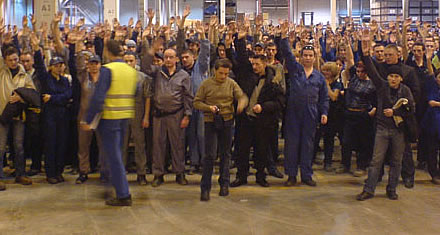Posted December 23, 2007

The strike at the Ford factory in Vsevolozhsk, located right outside St. Petersburg, ended on Dec. 14. It was the longest and most intense standoff in post-Soviet times. The strike began on Nov. 20 and continued for three weeks. According to union activists, the plant’s conveyors came to a full stop. Then management threw together one shift mainly composed of office workers and, toward the end of the strike, a second shift to keep the assembly line running. But the quality control department continued its strike, which means that cars produced in early December might not meet all of the technical standards.
During the strike, only a small number of cars came off the assembly line, and the company can expect to be counting its losses for a long time to come. The striking workers, for their part, are now morally and physically exhausted after fighting a long battle against management. The labor union’s strike fund was unprepared for such a protracted battle, OMON police forces harassed the picketers and the strike’s organizers were threatened with prosecution.
In the end, a general meeting of striking Ford workers voted in a secret ballot to halt the protest, and the company’s administration promised to raise their wages. Both sides signed an agreement prohibiting punitive actions against the strike’s participants.
The union and the company promise to settle all matters of dispute by Feb. 1. Union leader Alexei Etmanov said the Ford administration was already prepared to index salaries to keep pace with inflation and to provide additional pay for extra work and for length of service in the company. Etmanov characterized all of this as a victory, saying: “This strike turned out to be the most protracted in the past 10 years. I think the administration should agree to concessions. They would hardly want to see a new strike in the spring.”
The union achieved much less than expected, however. In addition to the concessions obtained, workers had demanded a 30 percent wage increase, higher pensions and changes to the work schedule and the number of work hours per day.
It would appear that the confrontation ended in a draw. The management failed to break the union, and the striking workers walked away with only modest results, especially considering the tremendous effort and stress they went through to get what they wanted.
The conflict at the Ford factory took on significance far beyond the organization itself and even beyond the auto manufacturing industry in Russia. The media from all over the country covered the story extensively. This was the country’s first open-ended strike since the new Labor Code came into force several years ago. It was also the first strike that the authorities did not squash and in which its participants obtained a guarantee that they would not be subjected to reprisals. The strike once again demonstrated that the laws work against labor unions, but it also showed that strong workers’ organizations can find ways to get around many of those restrictions.

Finally, the Ford conflict forced many people to acknowledge that factory workers are shamefully underpaid in Russia — not only in comparison to Western Europe, but also with respect to analogous car plants in Latin American countries.
Ultimately, the fundamental issues in this strike concern not only Ford workers and managers, but all of society. Although the Ford factory is working again and things seem to be back to normal, we must all draw these important conclusions from this strike and understand that serious labor problems still remain in the country. The first stone has been thrown into the water, and the waves will continue rippling outward for a very long time.
Boris Kagarlitsky is the director of the Institute of Globalization Studies.
On February 4, a majority of workers at the plant voted to accept the agreement on a pay increase and additional benefits which was reached following the historic 20-day strike, the longest-ever in recent Russian history.
The lowest paid workers are getting a 21 percent increase, and on average the factory workers will earn US $1,030 per month. According to reports we’re getting from Russia, “the conflict is over with a great victory of workers, whose courage and international solidarity made the company engage in serious negotiations, leading to the setting up of new pay standards for the whole booming Russian auto industry.– from LabourStart
